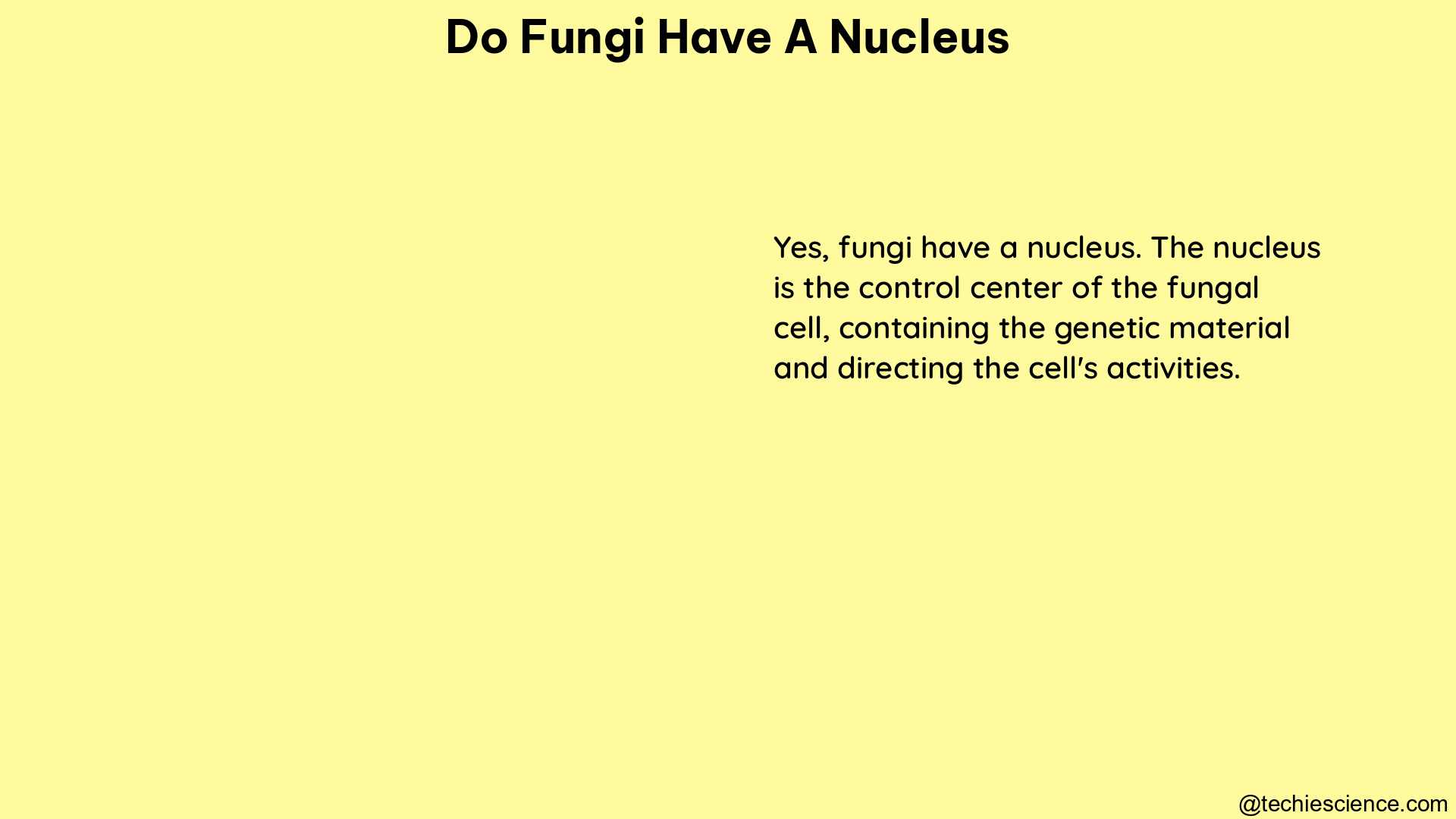Fungi, as eukaryotic organisms, possess a distinct membrane-bound organelle called the nucleus, which serves as the control center of the cell. The nucleus in fungi houses the genetic material, playing a crucial role in various cellular processes, including DNA replication, gene expression, and cellular division. Understanding the presence and characteristics of the fungal nucleus is essential for comprehending the fundamental biology of these diverse organisms.
The Presence of the Nucleus in Fungi
The presence of a nucleus in fungi has been well-established through various scientific investigations. Microscopic techniques, such as light microscopy and electron microscopy, have been instrumental in visualizing and studying the fungal nucleus. Staining methods, like DAPI (4′,6-diamidino-2-phenylindole) or Hoechst stains, which bind to the DNA, have been used to fluorescently label the nucleus, allowing for its clear identification within the fungal cell.
Furthermore, advanced imaging techniques, such as confocal microscopy and super-resolution microscopy, have provided high-resolution insights into the structure and organization of the fungal nucleus. These techniques have revealed the intricate details of the nuclear envelope, the nuclear pore complexes, and the arrangement of the genetic material within the nucleus.
Diversity in Fungal Nucleus Size and DNA Content

The size and DNA content of the fungal nucleus can vary significantly across different species and even within the same species. This diversity reflects the evolutionary adaptations and the unique genomic characteristics of various fungal taxa.
Genome Size Variation in Fungi
The average genome size of fungi is approximately 60 Mbp (megabase pairs), but this can range from as low as 2.2 Mbp in the microsporidian fungus Encephalitozoon romaleae to as high as 3,706 Mbp in the ascomycete fungus Jafnea semitosta. This vast range in genome size is attributed to factors such as gene duplication, transposable element proliferation, and the presence of introns and repetitive DNA sequences.
Ploidy Levels in Fungal Nuclei
Fungal nuclei can exhibit different ploidy levels, meaning they can contain varying numbers of chromosome sets. While many fungi are haploid, possessing a single set of chromosomes, some species can be diploid, tetraploid, or even polyploid, with multiple chromosome sets. This diversity in ploidy levels is often associated with specific life cycle stages, such as the sexual and asexual phases, and can have implications for fungal biology, including pathogenicity, stress tolerance, and adaptation.
Techniques for Studying Fungal Nuclei
Researchers have employed a variety of techniques to investigate the presence, structure, and characteristics of fungal nuclei. These techniques include:
- Microscopy:
- Light microscopy: Allows for the visualization of the fungal nucleus using staining methods, such as DAPI or Hoechst stains.
- Electron microscopy: Provides high-resolution images of the nuclear structure, including the nuclear envelope and the organization of the genetic material.
- Confocal microscopy: Enables the acquisition of high-quality, three-dimensional images of the fungal nucleus and its subcellular components.
-
Super-resolution microscopy: Offers unprecedented spatial resolution, allowing for the detailed study of nuclear architecture and dynamics.
-
Flow Cytometry:
- Flow cytometry is a powerful technique that can measure the DNA content of fungal nuclei, providing quantitative data on genome size and ploidy levels.
-
This method involves the rapid analysis of individual cells or nuclei as they pass through a laser beam, allowing for the accurate determination of the DNA content within the fungal nucleus.
-
Molecular Techniques:
- Genomic sequencing: The sequencing of fungal genomes has provided valuable insights into the size, organization, and composition of the genetic material within the fungal nucleus.
- Genetic engineering: Techniques like gene tagging and fluorescent protein labeling have enabled the visualization and study of specific nuclear components, such as chromosomes and nuclear pore complexes.
These diverse techniques have collectively contributed to our understanding of the presence, structure, and diversity of the fungal nucleus, highlighting its crucial role in the biology and evolution of these remarkable eukaryotic organisms.
Significance of the Fungal Nucleus
The presence of a nucleus in fungi is a fundamental characteristic that distinguishes them as eukaryotic organisms. The fungal nucleus plays a vital role in various cellular processes, including:
- Genetic Information Storage and Maintenance:
- The nucleus houses the genetic material, which is essential for the storage and transmission of hereditary information.
-
The nuclear envelope provides a protective environment for the genetic material, ensuring its integrity and proper segregation during cell division.
-
Gene Expression and Regulation:
- The nucleus is the site of transcription, where genetic information is converted into functional molecules, such as mRNA, rRNA, and tRNA.
-
Nuclear processes, such as chromatin remodeling and epigenetic modifications, regulate gene expression and cellular differentiation in fungi.
-
Cell Cycle and Division:
- The nucleus plays a crucial role in the coordination of the cell cycle, ensuring the accurate replication and segregation of the genetic material during cell division.
-
Nuclear events, such as chromosome condensation and spindle formation, are essential for the successful completion of mitosis and meiosis in fungi.
-
Cellular Compartmentalization and Signaling:
- The nuclear envelope serves as a physical barrier, separating the genetic material from the cytoplasm and facilitating the compartmentalization of cellular processes.
-
The nuclear pore complexes regulate the exchange of molecules, such as proteins and RNA, between the nucleus and the cytoplasm, enabling effective communication and coordination within the fungal cell.
-
Evolutionary Adaptations:
- The diversity in fungal nuclear size and DNA content reflects the evolutionary adaptations of different fungal species to their respective ecological niches and environmental challenges.
- Variations in ploidy levels and genome size can contribute to the adaptability and resilience of fungi, allowing them to thrive in diverse habitats and respond to changing conditions.
Understanding the presence and characteristics of the fungal nucleus is crucial for unraveling the fundamental biology of these eukaryotic organisms. The insights gained from the study of the fungal nucleus have far-reaching implications in fields such as fungal genetics, biotechnology, and the development of antifungal therapies.
Conclusion
In conclusion, fungi, as eukaryotic organisms, possess a distinct membrane-bound organelle called the nucleus. The presence of the nucleus in fungi has been well-established through various microscopic and molecular techniques, which have provided detailed insights into its structure, organization, and diversity. The size and DNA content of the fungal nucleus can vary significantly across different species, reflecting the evolutionary adaptations and unique genomic characteristics of these remarkable organisms. The fungal nucleus plays a crucial role in various cellular processes, including genetic information storage, gene expression, cell cycle regulation, and cellular compartmentalization. Understanding the presence and characteristics of the fungal nucleus is essential for advancing our knowledge of fungal biology and its applications in diverse fields.
Reference:
- Fungal Structures – an overview | ScienceDirect Topics: https://www.sciencedirect.com/topics/immunology-and-microbiology/fungal-structures
- Nuclear movement in fungi – PMC – NCBI: https://www.ncbi.nlm.nih.gov/pmc/articles/PMC5995604/
- Chapter 9 Flashcards – Quizlet: https://quizlet.com/504585789/chapter-9-flash-cards/
- Fungal Viability – an overview | ScienceDirect Topics: https://www.sciencedirect.com/topics/biochemistry-genetics-and-molecular-biology/fungal-viability
- The use of flow cytometry for fungal nuclear DNA quantification: https://onlinelibrary.wiley.com/doi/full/10.1002/cyto.a.24335

Hello, I am Bhairavi Rathod, I have completed my Master’s in Biotechnology and qualified ICAR NET 2021 in Agricultural Biotechnology. My area of specialization is Integrated Biotechnology. I have the experience to teach and write very complex things in a simple way for learners.